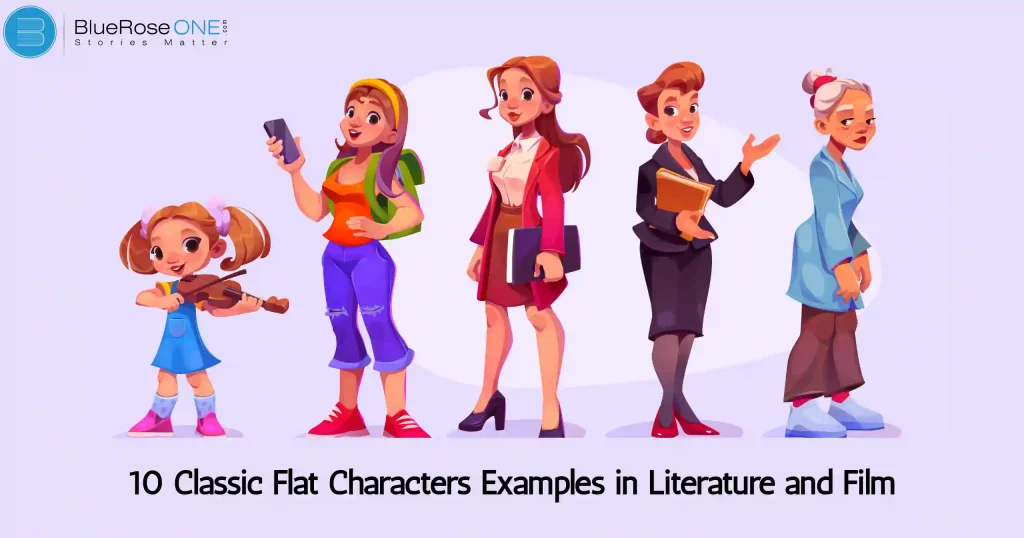
10 Classic Flat Character Examples in Literature and Film
Ever noticed how some characters in stories seem to have one job and do it well, no growth, no big twists, just there being their consistent, predictable selves? That’s a flat character for you. While they might not be the stars of the show, they hold the story together in surprising ways. In this article, we’re diving deep into the world of flat characters, flat character examples and breaking down 10 classic examples from both literature and film. Buckle up, it’s more fascinating than you might think! Table of Content Definition of Flat Characters Flat characters are the simple ones. They’re defined by one or two key traits and don’t really change throughout the story. They’re consistent, predictable, and often serve a very specific purpose. Think of them as the “what you see is what you get” people in a story. Traits of a Flat Character The Role of Flat Characters in Literature and Film Supporting the Protagonist Flat characters are frequently used as powerful tools to highlight and encourage the protagonist’s development. Their consistency contrasts with the hero’s complexity. These characters do not evolve, but instead serve as emotional anchors or moral compasses. They have consistent views or attitudes, allowing the protagonist’s metamorphosis to show. For example, in many classic stories, a faithful buddy or sidekick exists exclusively to aid the hero’s journey. Their presence highlights the protagonist’s inner conflicts without diverting attention. Flat characters reinforce themes and provide narrative consistency. Representing a Single Idea or Trait Flat characters are often designed to represent a single dominant idea or trait, serving as clear symbols within a story. Whether it’s loyalty, greed, innocence, or cruelty, these characters embody their defining quality without undergoing internal change. Their simplicity makes them effective tools for highlighting central themes or contrasting more complex characters. In both literature and film, flat characters help clarify the narrative by staying true to their role, making them memorable and essential despite their limited emotional or psychological depth. Providing Contrast or Consistency Flat characters play a vital role in providing contrast or consistency within a story. Their limited development allows them to act as steady reference points against which dynamic characters evolve. For instance, their unchanging traits can highlight the growth, flaws, or transformation of the protagonist. In contrast, flat characters may also reinforce a story’s theme or mood through their predictable behavior. Whether as comic relief, loyal sidekicks, or moral compasses, they bring clarity and balance to complex narratives without overshadowing the main plot. You may also like: 20 Satire Examples in Real-World Every Writer Should Know 10 Classic Flat Character Examples 1. Mr. Collins – Pride and Prejudice Mr. Collins from Pride and Prejudice is a prime example of a flat character. Throughout the novel, he remains pompous, obsequious, and blindly devoted to Lady Catherine de Bourgh. His exaggerated manners and lack of personal growth serve as comic relief and highlight the social satire central to Jane Austen’s narrative. 2. Mercutio – Romeo and Juliet Mercutio, Romeo’s witty and provocative friend in Shakespeare’s Romeo and Juliet, is a classic flat character. He remains bold, sarcastic, and cynical throughout the play. His consistent traits provide comic relief and contrast Romeo’s romanticism, but Mercutio’s unwavering demeanor also sets the stage for the tragic turn in the story. 3. Miss Trunchbull – Matilda Miss Trunchbull from Matilda is a classic flat character, embodying tyranny and cruelty without much emotional depth or change. As the authoritarian headmistress, she serves as a clear antagonist, reinforcing the story’s conflict. Her exaggerated villainy highlights Matilda’s courage and resilience, making her a memorable and effective literary foil. 4. Crabbe and Goyle – Harry Potter Crabbe and Goyle from Harry Potter serve as classic flat characters, consistently portrayed as Draco Malfoy’s dull-witted, loyal henchmen. Their limited development and repetitive behavior bullying others and blindly following Draco highlight their narrative role as static antagonists. They provide comic relief and contrast to the more dynamic main characters. 5. Bruce the Shark – Finding Nemo Bruce, the great white shark in Finding Nemo, serves as a classic flat character. His personality is defined by a single comedic trait: his struggle to resist eating fish, summed up by his motto, “Fish are friends, not food.” Bruce’s character doesn’t evolve, maintaining his humorous contradiction throughout the film. 6. The Wicked Witch of the West – The Wizard of Oz The Wicked Witch of the West from The Wizard of Oz is a prime flat character, driven solely by revenge and cruelty. She lacks depth or transformation, serving as a constant antagonist. Her unwavering evil highlights Dorothy’s goodness, making her a classic example of a one-dimensional villain in literature and film. 7. Scar – The Lion King Scar from The Lion King is a classic flat character driven by jealousy and ambition. His personality remains consistent, manipulative, cunning, and power-hungry throughout the film. Scar’s lack of character growth reinforces his role as a villain, making him a clear, unchanging antagonist in contrast to Simba’s evolving hero journey. 8. Javert – Les Misérables Javert from Les Misérables is a classic flat character defined by his unwavering commitment to law and order. Throughout the novel, he relentlessly pursues justice, unable to reconcile his rigid beliefs with moral complexity. His lack of character evolution highlights the dangers of blind adherence to authority and rules. 9. Frankenstein’s Monster – Frankenstein Frankenstein’s Monster in Mary Shelley’s Frankenstein is another classic flat character, primarily defined by his tragic isolation and yearning for acceptance. Though he evolves emotionally, he remains largely consistent in his sorrow and rejection. His role highlights society’s fear of the unknown, reinforcing the novel’s central themes of alienation and identity. 10. Bellatrix Lestrange – Harry Potter Bellatrix Lestrange is a quintessential flat character in the Harry Potter series, defined by her unwavering loyalty to Voldemort and unrelenting cruelty. She remains consistently sadistic and obsessed with dark magic, showing no moral growth or complexity. Her single-minded devotion makes her a powerful, yet one-dimensional antagonist throughout…
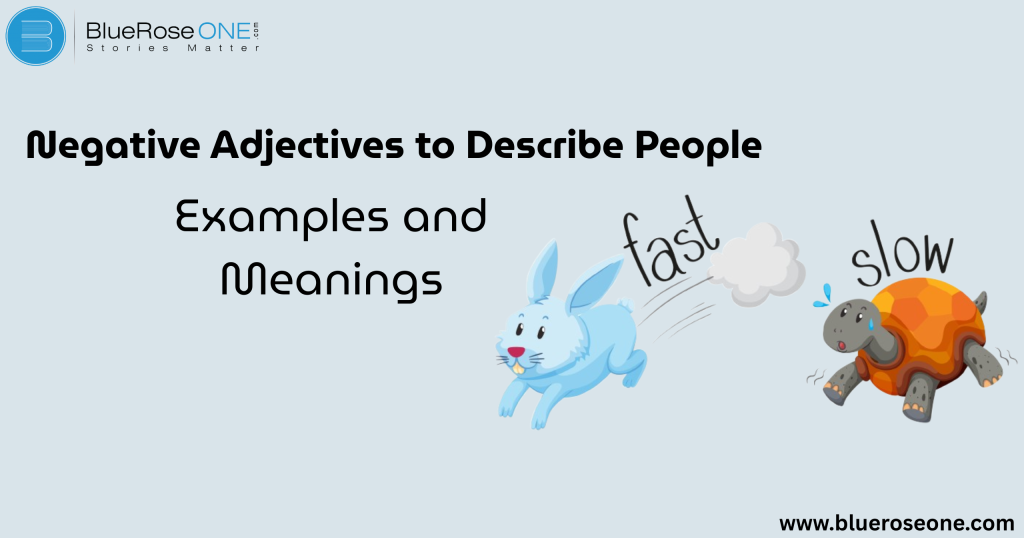
Negative Adjectives to Describe People: Examples and Meanings
Words matter, especially when they describe people. We’ve all been called something that stung maybe “lazy” or “arrogant” and we’ve probably said something similar about others too. But what exactly are negative adjectives, and why should we care about them? Negative adjectives are words we use to describe people in less-than-flattering ways. They pinpoint flaws, weaknesses, and unpleasant characteristics. But here’s the thing—understanding these words can help us communicate better, set clear boundaries, and even understand ourselves on a deeper level. The Power of Words How Adjectives Shape Perception Think about it, would you rather be described as “direct” or “rude”? The line is thin, but the impact is massive. Adjectives shape how others see us and how we see them. Impact of Negative Language in Communication When we label someone with a harsh word, it sticks. Whether in the office, at home, or among friends, our words carry emotional weight. Using negative adjectives irresponsibly can burn bridges before they’re even built. You may also read: Archangels Names List: Meanings, Powers, and Symbolism Psychological Effects of Negative Labels Negative labels can have lasting psychological effects, particularly when used repeatedly to describe a person’s identity. Being called terms like “lazy,” “selfish,” or “worthless” can lead to internalized self-doubt, low self-esteem, and a fixed mindset. This phenomenon, known as labeling theory in psychology, suggests that individuals may begin to act in accordance with the labels assigned to them. Over time, such adjectives can damage motivation, hinder personal growth, and contribute to anxiety or depression. Cultural Context and Subjectivity The perception and use of negative adjectives are heavily impacted by cultural context and individual subjective experiences. What is considered insulting or harsh in one culture may be perceived as direct or even acceptable in another. For example, labeling someone “stubborn” may suggest resolve in some cultures but be considered rude in others. Personal beliefs, society standards, and regional linguistic variances all influence how negative features are labeled and interpreted, so context is essential in communication. You may also read: 150+ Positive Words That Start with O to Brighten Your Vocabulary When and How to Use Negative Adjectives Carefully It’s crucial to use negative adjectives sparingly so that your point is understood without being unduly hurtful. When truthful, helpful, or required to express a certain quality as in character descriptions, critical assessments, or candid discussions these terms ought to be employed. But context and tone are important. Steer clear of employing them in emotionally sensitive or conflict-escalating circumstances. Instead, to foster understanding and uphold polite speech, use negative adjectives with empathy or context. Common Negative Adjectives to Describe People Let’s break these down into categories to make them easier to digest. Personality-Based Adjectives Arrogant – Believes they’re better than others; looks down on people. Moody – Swings between emotions unpredictably. Selfish – Always puts their own needs first. Behavior-Based Adjectives Rude – Lacks basic politeness; often offends unintentionally or not. Aggressive – Pushy, dominating, often intimidating. Manipulative – Uses deceit to control others for personal gain. Intelligence-Based Adjectives Ignorant – Lacks knowledge, and often shows no interest in learning. Gullible – Easily fooled or misled. Dense – Struggles to understand basic concepts or social cues. Work Ethic and Reliability Lazy – Avoids effort or responsibility. Irresponsible – Doesn’t take ownership of tasks or consequences. Unreliable – Can’t be counted on when needed. You may also like: 100+ Powerful Descriptive Adjectives to Make Your Writing Vivid Replacing Harshness With Constructive Language Instead of: “You’re lazy” → Try “I noticed you’ve been less active lately. Is everything okay?” “You’re aggressive” → Try “I feel overwhelmed when our conversations get intense.” Reframing helps maintain respect while addressing the issue. Why You Should Expand Your Negative Adjective Vocabulary Knowing more precise words lets you communicate better. Instead of calling someone “mean,” maybe they’re “sarcastic,” “condescending,” or “insensitive.” See the difference? Being specific shows emotional intelligence and that’s attractive in any relationship. You may also read: 400 Adjectives That Start with L to Level Up Your Vocabulary Table of 50+ Negative Adjectives With Meanings Adjective Meaning Arrogant Overconfident and dismissive of others Cynical Always expects the worst Impatient Easily irritated by delays Hostile Openly aggressive or unfriendly Deceitful Frequently lies or misleads Moody Emotionally unstable Jealous Envious of others’ success or happiness Overbearing Dominates and controls others Callous Lacks empathy or concern Grumpy Frequently irritable or bad-tempered Vain Obsessed with appearance or self-image Inflexible Unwilling to change or adapt Judgmental Quickly forms negative opinions of others Petty Concerned with trivial matters Clingy Overly dependent or emotionally needy Manipulative Controls others through deceit Boastful Brags excessively Obnoxious Annoyingly loud or intrusive Passive Avoids confrontation, overly submissive Cold Emotionally distant Irresponsible Doesn’t take accountability Insensitive Unaware of others’ feelings Sarcastic Uses cutting or ironic remarks Stubborn Refuses to compromise or listen Unpredictable Behavior changes often and without reason Real-Life Situations Where These Adjectives Are Used Workplace Conflicts: Calling a co-worker “lazy” can damage collaboration. Toxic Relationships: Words like “manipulative” or “jealous” define unhealthy dynamics. Academic Settings: A student labeled “dense” might stop trying altogether. How to Handle Negatively Described People Set boundaries. Communicate clearly. Don’t engage in name-calling. Focus on behavior, not identity. You may also like: 100+ Adjectives Begin with N (With Meanings & Examples) Conclusion Negative adjectives are more than just words. They’re reflections of behaviors, attitudes, and patterns we encounter and sometimes exhibit. Use them wisely, understand them deeply, and always aim for respectful, clear communication. Frequently Asked Questions 1. Are all negative adjectives bad? Not always. Some can highlight important red flags or be used to set boundaries respectfully. 2. Can negative adjectives ever be helpful? Yes, when used constructively, they can point out behaviors that need improvement. 3. How to give feedback without offending? Focus on the behavior, use soft language, and always offer support or solutions. 4. Are some negative adjectives culturally biased? Absolutely. What’s seen as “rude” in one culture might be normal in another. 5. What’s the best way to describe someone difficult? Choose specific,…
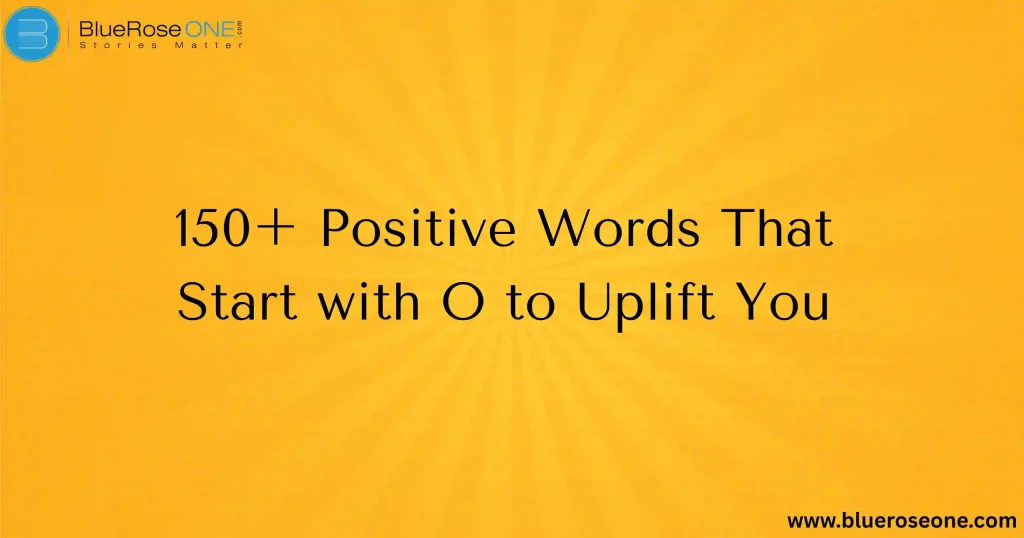
150+ Positive Words That Start with O to Brighten Your Vocabulary
Are you on the hunt for words that start with O to add a touch of optimism and originality to your writing and conversations? Look no further! While “O” might seem like a humble letter, it unlocks a treasure trove of positive vocabulary. Expanding your word choice not only enhances your communication but also allows you to express nuanced emotions and ideas more effectively. In this comprehensive list, we’ve gathered over 150 positive words beginning with “O” to enrich your lexicon. Whether you’re a writer, a student, a public speaker, or simply someone who loves words, this collection will help you discover new ways to articulate positivity, opportunity, and excellence. You may also read: Archangels Names List: Meanings, Powers, and Symbolism Why Focus on Positive Words? The words we choose have a profound impact on how we perceive the world and how others perceive us. Using positive language can: Boost your mood: Focusing on positive words can shift your mindset. Improve communication: Convey your message with clarity and a positive tone. Enhance creativity: A wider vocabulary opens up new avenues for expression. Build stronger relationships: Positive language fosters connection and understanding. Over 150 Positive Words That Start with O Let’s dive into our extensive list of uplifting and impactful words! Common and Useful “O” Words These are words you might already know, but their positive connotations are worth highlighting: Open: Receptive, honest, accessible. Optimistic: Hopeful and confident about the future. Outstanding: Exceptionally good. Original: New, fresh, unique. Outgoing: Friendly and sociable. Overall: Including everything. Obliging: Willing to do favors; helpful. Orderly: Neatly and methodically arranged. Okay: All right; acceptable. Onward: Moving forward. You may also like: 400 Adjectives That Start with L to Level Up Your Vocabulary You may also read: Sage Archetype: Meaning and Tips for Writers Describing People and Qualities Use these words to describe individuals with admirable traits: Objective: Not influenced by personal feelings or opinions in considering facts. Observant: Quick to notice things. Obtainable: Able to be obtained. Open-minded: Willing to consider new ideas. Optimistic: Hopeful and confident about the future. Orderly: Well-behaved; systematic. Organized: Arranged in a systematic way; efficient. Ornate: Elaborately decorated (can be positive in an artistic context). Outgoing: Friendly and socially confident. Outstanding: Exceptionally good. Overjoyed: Extremely happy. Overcoming: Successfully dealing with a problem or difficulty. Opportune: Well-chosen or particularly favorable. Omniscient: Knowing everything (often used in a positive, admiring context for narratives or deities). On-time: Punctual. Opulent: Rich and luxurious. Describing Actions and States These words express positive actions, feelings, or conditions: Operate: To function effectively. Optimize: To make the best or most effective use of a situation or resource. Originating: Beginning; coming into existence. Overachieve: To perform better than expected. Overcome: To successfully deal with a problem or difficulty. Overjoyed: Extremely happy. Oversee: To supervise. Ownership: The act of possessing something; responsibility. Openness: The quality of being frank and unreserved. Opportunity: A set of circumstances that makes it possible to do something. Orientation: The relative position or direction of something. Outstanding: Prominent; excellent. Overdrive: A state of great activity or energy. Overjoyed: Feeling immense pleasure and happiness. Ovation: Enthusiastic public applause. You may also like: 200 Adjectives That Start with A to Boost Your Writing More Positive “O” Words for a Richer Vocabulary Oath: A solemn promise. Obelisk: A tall, four-sided, narrow tapering monument (often symbolic of achievement). Oblation: An offering or sacrifice. Oblige: To make someone legally or morally bound to an action or course of action. Observable: Able to be seen or noticed. Oneness: The state of being unified or whole. Onset: The beginning of something, especially something good. Openhearted: Kind and sympathetic. Open-handed: Generous. Operative: Functioning; effective. Opinionated: (Can be positive when describing someone who has strong, well-reasoned beliefs). Opponent: (Can be positive in competitive contexts, implying a worthy challenge). Optimal: Best or most favorable. Optimum: The best possible conditions. Opulence: Great wealth or luxuriousness. Oracular: Relating to an oracle; prophetic (can be positive in a wise or insightful way). Oratory: The art of public speaking, especially eloquent speaking. Orchestrate: To arrange or coordinate. Organic: Produced without artificial chemicals; natural. Ornamental: Serving as an ornament; decorative. Orthodox: Following traditional or established beliefs (can be positive in terms of reliability). Outgoingness: The quality of being friendly and sociable. Outgrow: To grow too large for; to develop beyond. Outlast: To last longer than. Outline: A general description or plan. Outlive: To live longer than. Outlook: A person’s point of view or general attitude to life. Outperform: To perform better than. Outpouring: A strong and rapid flow of something. Outreach: The extent or length of reaching out. Outshine: To surpass in splendor, ability, or achievement. Outstandingly: In an exceptionally good way. Outstretch: To extend outwards. Outstrip: To move faster than and get ahead of. Outwit: To defeat by ingenuity. Overall: Comprehensive; total. Overarching: Comprehensive or all-embracing. Overbearing: (Can be positive when describing a strong, protective presence). Overjoyed: Extremely happy. Overpowering: (Can be positive when describing overwhelming beauty or emotion). Overseeing: Supervising. Overthrow: (Can be positive when overthrowing a negative system). Overtly: Openly; plainly. Owe: (Can be positive when acknowledging gratitude or a debt of kindness). Own: To possess; to acknowledge. Owner: A person who owns something. Ownership: The act, state, or right of possessing something. Ozone: A form of oxygen (positive in environmental contexts) You may also like: 100+ Powerful Descriptive Adjectives to Make Your Writing Vivid Even More “O” Words to Explore! Obligatory (in a positive sense, like an obligatory kind gesture) Objective (as a goal) Oblivious (can be positive in avoiding negativity) Obsession (positive when applied to a healthy passion) On-board Ongoing Only (as in “the one and only”) Open-ended Open-eyed Open-faced Operable Opinionated (in a confident, well-reasoned way) Opposite (can be positive for contrast) Opulently Oral (as in “oral tradition” or “oral history”) Oratory (skillful public speaking) Orbed Orderliness Organic (natural) Organism Organizational Oriented Originality Originally Ornate (beautifully decorated) Orthodox (reliable, traditional) Outbound Outcome Outdoor Outer Outfitter Outgoingly Outpouring (of love, support) Outright Outside (as in “outside the box” thinking) Outspoken…
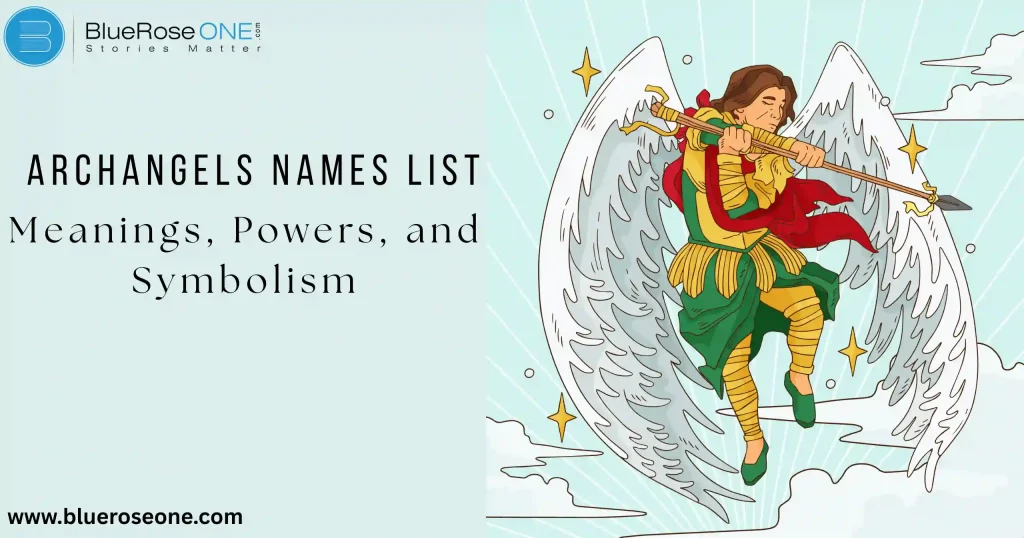
Archangels Names List: Meanings, Powers, and Symbolism
Ever felt a sudden wave of peace or an unexplainable gut feeling that saved you from a bad situation? That might have been the work of an archangel. These divine warriors and messengers serve as cosmic first responders. Curious about who they are, what they do, and how to recognize them? Let’s uncover the sacred stories and deep symbolism behind these mighty beings. Understanding the Role of Archangels Names Difference Between Angels and Archangels While both angels and archangels are celestial beings, they differ in rank, role, and responsibilities. Angels are considered messengers and protectors who work closely with humans, offering guidance and support in everyday life. Archangels, on the other hand, hold a higher position in the heavenly hierarchy and oversee the work of angels. Known for their powerful presence and leadership, they are often associated with specific divine missions. Understanding this distinction enhances clarity when exploring Archangels Names and their unique symbolism. You may also like: 200 Adjectives That Start with A to Boost Your Writing Archangels in Different Religions Christianity often references Michael, Gabriel, and Raphael. Judaism recognizes seven archangels mentioned in apocryphal texts like the Book of Enoch. Islam holds Gabriel (Jibril) and Michael (Mikail) in high esteem as divine messengers. Despite theological differences, most major religions accept that these beings guide, protect, and deliver divine insight. The Seven Main Archangels – Archangels Names List 1. Archangel Michael Meaning: “Who is like God?” Powers: Protection, strength, courage. Symbolism: Sword, shield, blue flame. Michael is the chief protector of humanity. If you’re ever in need of bravery, strength, or safety, he’s your go-to archangel. Many call on him for clearing negativity and fighting spiritual battles. 2. Archangel Gabriel Meaning: “God is my strength.” Powers: Communication, revelation, clarity. Symbolism: Trumpet, white lilies, light. Gabriel is the archangel of communication and divine messages. He’s often associated with creativity, childbirth, and new beginnings. Feeling stuck or unclear? Gabriel brings clarity and purpose. You may also read: 100+ Powerful Descriptive Adjectives to Make Your Writing Vivid You may also like: List of Richard Osman Books in Order: Complete Reading Guide 3. Archangel Raphael Meaning: “God heals.” Powers: Healing, compassion, travel. Symbolism: Staff, green light, fish. Raphael is the healer of the angelic realm. He helps with physical, emotional, and spiritual healing. He’s also the patron of travelers and healthcare workers. 4. Archangel Uriel Meaning: “God is my light.” Powers: Wisdom, insight, truth. Symbolism: Flame, scroll, red light. Uriel is all about intellectual enlightenment. If you need solutions, answers, or a flash of insight, he’s your divine tutor. Uriel also helps with emotional balance and understanding karma. You may also like: 100+ Adjectives That Start With N (With Examples & Definitions) You may also like: 20 Satire Examples in Real-World Every Writer Should Know 5. Archangel Chamuel Meaning: “He who sees God.” Powers: Love, peace, reconciliation. Symbolism: Heart, pink light, dove. Chamuel heals broken relationships and brings peace to your heart. If you’re dealing with conflict, grief, or loneliness, his loving energy helps restore harmony. 6. Archangel Zadkiel Meaning: “Righteousness of God.” Powers: Forgiveness, mercy, transformation. Symbolism: Violet flame, scales, cloak. Zadkiel guides you in releasing guilt and emotional wounds. He’s the angel of spiritual alchemy—turning your pain into power. You may also like: 100+ Adjectives That Start with T to Boost your Writing You may also read: Sage Archetype: Meaning and Tips for Writers 7. Archangel Jophiel Meaning: “Beauty of God.” Powers: Positivity, creativity, inspiration. Symbolism: Yellow light, sunflowers, mirror. Feeling uninspired? Call on Jophiel for a burst of creativity. She brightens your thoughts and surroundings, helping you see the beauty in all things. Lesser-Known Archangel Names and Their Roles Archangel Metatron Archangel Metatron is a powerful yet lesser-known figure often associated with divine wisdom and the Akashic Records. Once believed to be the prophet Enoch, Metatron was transformed into an archangel and now serves as a celestial scribe, recording every soul’s deeds. Revered in mystical traditions, he governs spiritual guidance, sacred geometry, and ascension. Among the Archangels’ Names, Metatron stands out as a guardian of spiritual truth and a bridge between Heaven and Earth. Archangel Sandalphon Archangel Sandalphon is one of the lesser-known yet powerful figures in the realm of divine messengers. Often associated with music and prayer, Sandalphon is believed to carry human prayers to the heavens, acting as an intercessor between Earth and the Divine. Traditionally seen as the twin of Archangel Metatron, Sandalphon is also linked to the spiritual power of sound and sacred music. Among the Archangels’ Names, Sandalphon stands out for his gentle guidance and connection to divine harmony. You may also read: 150 Adjectives Begin with R Popular in Literature Archangel Raguel Archangel Raguel, one of the lesser-known names on the Archangels List, is recognized as the Angel of Justice, Harmony, and Fairness. His name means “Friend of God,” and his divine function include resolving conflicts and restoring harmony among celestials and humans alike. Raguel works behind the scenes to promote justice and align individuals with the divine plan. He is frequently relied upon to assist people rediscover emotional balance and restore harmony in their spiritual and personal lives, as well as to heal broken relationships. How to Connect With Archangels Prayers and Meditations One of the most powerful ways to connect with divine beings is through focused prayers and meditations dedicated to specific archangels. By calling on archangels by name—such as Michael for protection or Raphael for healing—you can invoke their unique energies and guidance. Repeating their names during meditation aligns your spirit with their celestial frequency. Regular spiritual practice not only strengthens your connection but also deepens your understanding of the meanings and powers behind Archangels Names. You may also like: 10 Best Fiction Books Set in America You Must Read Signs They Are Near Tingling or warmth in your body Seeing feathers, coins, or repetitive numbers Vivid dreams or sudden clarity Crystals and Symbols Associated with Each Archangel Michael: Lapis Lazuli, Sword Gabriel: Moonstone, Trumpet Raphael: Emerald, Caduceus Uriel: Amber, Flame Chamuel: Rose Quartz, Heart Zadkiel: Amethyst, Violet Flame…
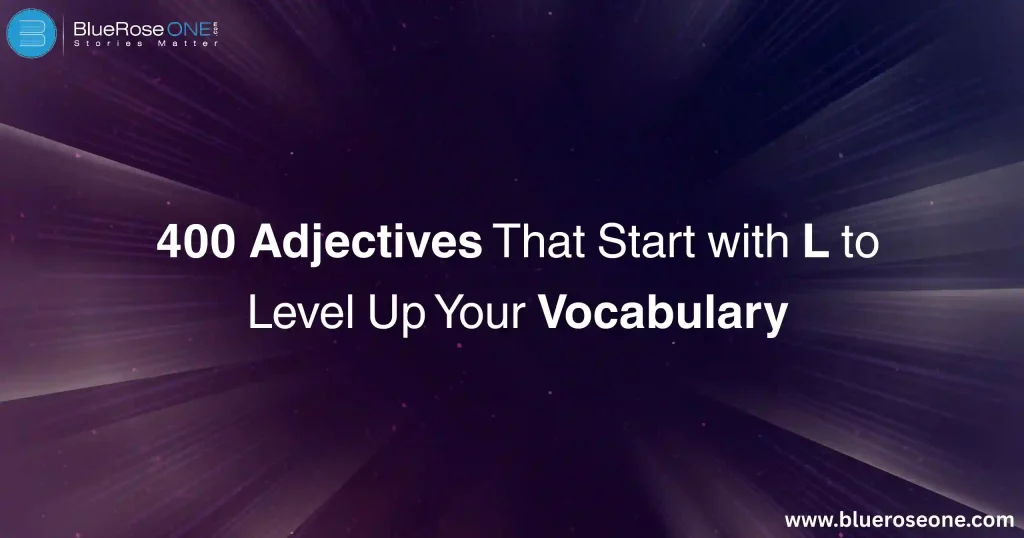
400 Adjectives That Start with L to Level Up Your Vocabulary
Whether you’re a student, a writer, or just someone passionate about words, having a strong adjective vocabulary can help you express ideas more vividly and precisely. This article brings you 400 adjectives starting with the letter L, grouped by tone and usage to make learning easy and enjoyable. Positive Adjectives That Start with L These uplifting adjectives are perfect for complimenting people, describing beautiful things, or inspiring your audience. Lively Lucky Lovable Loyal Luxurious Logical Learned Lighthearted Laudable Loving Legendary Leading Luminous Lucid Liberal Legitimate Likable Lustrous Lavish Limitless You may also like: 200 Adjectives That Start with A to Boost Your Writing Negative Adjectives That Start with L Use these for critique, fiction, or when expressing dissatisfaction or concern. Lousy Lazy Lethargic Loathsome Lonely Lopsided Lame Leaky Lewd Lurid Lacking Livid Languid Larcenous Lowbrow Licentious Lamentable Lunatic Lost Lopsided Personality Adjectives Starting with L Great for character descriptions in fiction or real-life observations. Loyal Loving Level-headed Laid-back Light-hearted Lively Logical Leaderlike Lucky Lenient Lustful Loquacious Lame Listless Like-minded Laughable Lecherous Loud Lucid Lonely You may also read: 100+ Powerful Descriptive Adjectives to Make Your Writing Vivid You may also like: Left Behind Series Books in Order: Where to Begin Descriptive Adjectives for Things, Places, or Experiences Use these to describe objects, settings, or sensory experiences. Large Little Long Low Lush Lavish Leafy Luminous Lofty Light Limited Leathery Linear Lumpy Lifeless Lethal Loud Lustrous Liquid Logical Rare and Sophisticated ‘L’ Adjectives Want to sound erudite? Use these uncommon but powerful adjectives. Lyrical Latitudinal Lilliputian Labyrinthine Languorous Lithic Lapidary Lunate Lexical Levitational Liminal Lamplit Linguistic Leguminous Lacerating Lacerative Lamentatory Luminiferous Laniary Lomentaceous You may also like: 100+ Adjectives That Start With N (With Examples & Definitions) Creative Writing Picks: Evocative and Expressive Adjectives Perfect for poets, novelists, and storytellers. Luminous Lurking Languid Lamenting Laughing Leaping Lonesome Lustful Listless Lucent Lethargic Lavish Lyrical Lingering Limber Looming Lacerated Living Loveless Lush You may also like: 100+ Adjectives That Start with T to Boost your Writing 400 ‘L’ Adjectives: Complete List (A–Z Style) Here’s the full list, alphabetically arranged for easy reference: A–D: Labored Lacking Lacy Lame Lamentable Laminar Languid Lanky Larcenous Large Lascivious Lasting Late Latent Lateral Latest Laughable Lawful Lazy Leading E–H: 21. Leafy 22. Leaky 23. Lean 24. Learned 25. Lecherous 26. Leftist 27. Legal 28. Legitimate 29. Leisurely 30. Lethal 31. Lethargic 32. Level-headed 33. Lewd 34. Light 35. Light-hearted 36. Likable 37. Limber 38. Limited 39. Limp 40. Lingering I–L: 41. Linguistic 42. Liquid 43. Listless 44. Literal 45. Literary 46. Lithe 47. Lithographic 48. Little 49. Lively 50. Livid 51. Lofty 52. Logical 53. Lonely 54. Long 55. Long-lasting 56. Long-term 57. Loopy 58. Loose 59. Loquacious 60. Lost M–P: 61. Loud 62. Lovely 63. Loving 64. Low 65. Low-key 66. Low-maintenance 67. Lowly 68. Loyal 69. Lucent 70. Lucid 71. Lucky 72. Ludicrous 73. Luminous 74. Lumpy 75. Lurid 76. Lustful 77. Lustrous 78. Luxurious 79. Lyric 80. Lyrical You may also read: 100+ Adjectives Begin with N (With Meanings & Examples) Conclusion Whether you’re writing a compelling novel, crafting a poem, or just want to sound smarter in conversation, these adjectives starting with “L” will elevate your expression. Bookmark this list for regular vocabulary boosts!
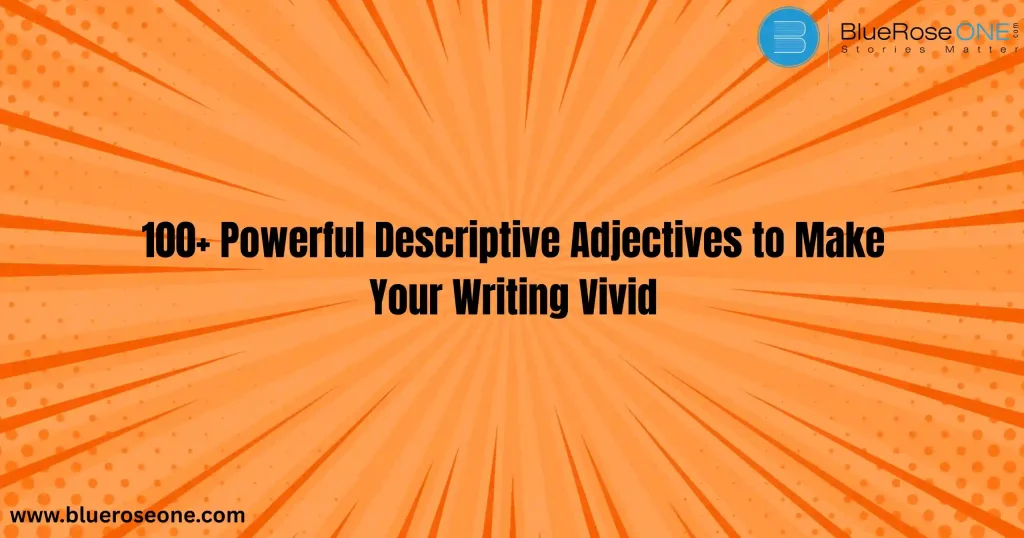
100+ Powerful Descriptive Adjectives to Make Your Writing Vivid
Ever read a sentence so vivid that you could taste the air or feel the tension? That’s the power of a good adjective. Descriptive adjectives take flat, lifeless writing and breathe emotion, color, and energy into it. If your writing feels dull or robotic, you might just be missing the right words to paint your picture. Let’s change that. What Are Descriptive Adjectives? Descriptive adjectives are words that modify nouns or pronouns by providing information about their qualities – like color, size, shape, emotion, or condition. They answer questions like what kind?, how many?, or which one? Difference Between Descriptive and Limiting Adjectives Descriptive adjectives and limiting adjectives serve distinct functions in writing. Descriptive adjectives add detail, color, and emotion by describing qualities such as size, color, shape, or mood—words like brilliant, fragile, or cheerful enrich the imagery and tone of sentences. In contrast, limiting adjectives restrict or define the noun rather than describe it. These include words like each, few, many, this, or my, which help specify which or how many items are being discussed. While descriptive adjectives enhance creativity and vividness, limiting adjectives provide clarity, focus, and structure in communication by narrowing the scope of the noun. You may also read: 200 Adjectives That Start with A to Boost Your Writing How Descriptive Adjectives Transform Your Writing Painting Pictures with Words Descriptive adjectives play a vital role in transforming ordinary writing into vivid, immersive experiences. By carefully choosing precise and evocative adjectives, writers can paint mental pictures that engage the reader’s senses and emotions. Instead of saying “a flower,” using “a delicate, crimson flower” immediately brings color, texture, and mood into focus. This power to “paint with words” allows authors to show rather than tell, making scenes more memorable and characters more relatable. Whether describing a stormy night or a joyful celebration, descriptive adjectives enhance clarity, spark imagination, and breathe life into every sentence. Setting the Mood and Tone Descriptive adjectives serve an important part in determining the mood and tone of a piece of writing. Writers can directly impact how readers feel and perceive a narrative by carefully choosing adjectives that convey specific emotions—for example, “gloomy” for a dark scene or “radiant” for a cheerful moment. These adjectives serve to create mood and emotional context, whether it’s a thrilling thriller or a sweet romance. The appropriate word choice enables the writer to steer the reader’s emotional journey, enhancing the immersion and engagement. In essence, descriptive adjectives serve as effective instruments for influencing the overall impact of the story. You may also read: 100+ Adjectives That Start with T to Boost your Writing Enhancing Character and Scene Descriptions Descriptive adjectives serve an important function in improving the quality of character and scene depictions in writing. Writers can paint sharper mental images by using vivid and particular modifiers, allowing readers to more intensely visualize situations and individuals. Instead of just mentioning “a man entered the room,” characterizing him as “a tall, brooding man in a tattered coat” immediately adds depth and mystery. A “sunny day” becomes more immersive when characterized as “a radiant, golden morning with crisp air.” These properly picked adjectives not only improve sensory detail, but they also elicit emotions, enrich tone, and effectively create atmosphere. You may also like: 20 Satire Examples in Real-World Every Writer Should Know List of 100+ Powerful Descriptive Adjectives Descriptive Adjectives for Appearance People Radiant Slender Muscular Wrinkled Elegant Disheveled Petite Chiseled Graceful Shabby Objects Glossy Polished Ancient Cracked Dusty Gleaming Intricate Bulky Tarnished Pristine Descriptive Adjectives for Emotions Joyful Anxious Melancholic Hopeful Furious Ecstatic Gloomy Restless Content Agitated Descriptive Adjectives for Taste and Smell Spicy Bitter Tangy Pungent Aromatic Bland Zesty Smoky Sweet Rotten Descriptive Adjectives for Sound Hushed Roaring Echoing Shrill Melodic Muffled Piercing Soothing Clanging Whispering Descriptive Adjectives for Texture and Touch Velvety Rough Slick Sticky Bumpy Coarse Gritty Fluffy Jagged Smooth You may also like: 100+ Adjectives Begin with N (With Meanings & Examples) Descriptive Adjectives for Size and Shape Towering Petite Bulky Spherical Slim Flat Enormous Lanky Miniature Plump Descriptive Adjectives for Weather and Nature Windy Frosty Scorching Misty Breezy Humid Stormy Dewy Chilly Radiant Descriptive Adjectives for Color and Light Crimson Golden Murky Luminous Shadowy Dazzling Pale Vivid Ashen Fiery You may also like: 150 Adjectives Begin with R Popular in Literature Creative Uses of Descriptive Adjectives In Storytelling and Fiction In storytelling and fiction, descriptive adjectives are essential for creating vivid images, emotional depth, and immersive surroundings. They assist writers in creating vivid characters and evoking moods that pull readers into the story. For example, describing a forest as “gloomy” rather than simply “dark” adds a haunting, emotive depth. Carefully chosen adjectives can also influence readers’ views, transforming a “timid child” into a symbol of fragility or a “grizzled warrior” into an emblem of experience and strength. In Poetry In poetry, descriptive adjectives play a vital role in evoking emotions, painting vivid imagery, and enhancing rhythm. Poets often use these adjectives to breathe life into abstract ideas, making feelings like sorrow, joy, or wonder more tangible. For example, words like “whispering winds” or “dusky skies” create sensory experiences that resonate with readers. Carefully chosen adjectives enrich poetic language, adding depth and nuance while allowing poets to express complex themes with brevity and beauty. In Marketing and Copywriting Descriptive adjectives play a crucial role in marketing and copywriting by appealing directly to emotions and enhancing product appeal. Words like “luxurious,” “crisp,” or “invigorating” instantly paint a vivid picture and influence consumer perception. These adjectives help craft persuasive messages that capture attention, build brand identity, and drive action. Whether used in product descriptions, ad headlines, or social media captions, well-chosen adjectives make content more compelling and memorable, turning ordinary messages into powerful calls to action. You may also like: 100+ Adjectives That Start With N (With Examples & Definitions) Tips for Using Descriptive Adjectives Effectively Avoiding Overuse and Redundancy While descriptive adjectives can improve your writing, overusing them can result in cluttered and repetitive text. Writers should strive for…
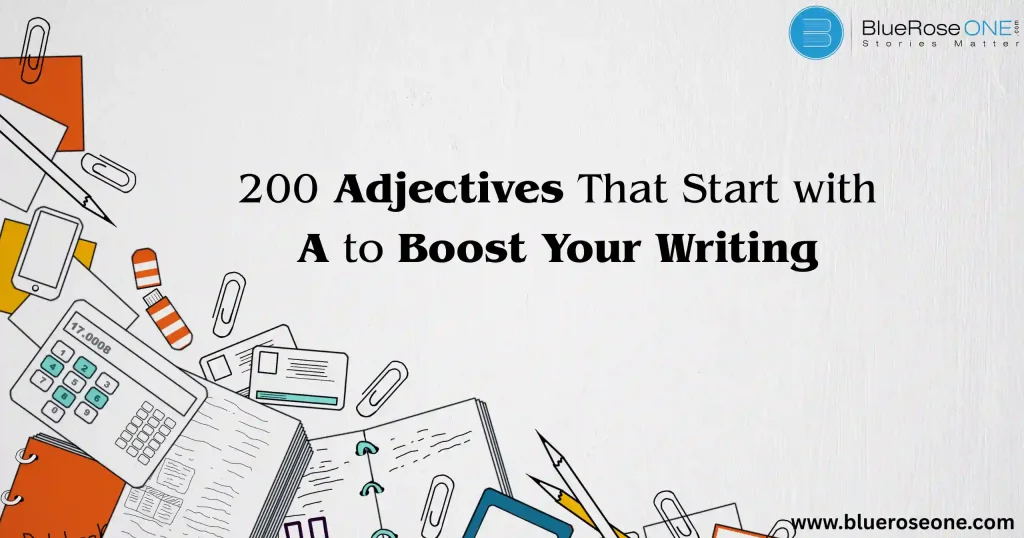
200 Adjectives That Start with A to Boost Your Writing
Have you ever found yourself lost for words when trying to describe something? That’s where adjectives come in and they’re more powerful than you might think! Adjectives give our language color, emotion, and clarity. They help us paint vivid pictures with our words. And today? We’re diving into the world of adjectives that start with the letter A—a treasure chest of words that are amusing, articulate, and absolutely awesome. List of 200 Adjectives That Start with A Let’s explore a mega list of 200 adjectives starting with A. We’ve divided them for easier learning and usage. Positive Adjectives Starting with A Describing Personality Affable – Friendly and easy to talk to Amiable – Good-natured, cheerful Ambitious – Having a strong desire for success Admirable – Worthy of admiration Artistic – Creative and imaginative Appreciative – Showing gratitude Assertive – Confident and direct Agreeable – Pleasant, likable Altruistic – Selfless and giving Adaptable – Able to adjust easily Describing Appearance Attractive – Pleasing to the eye Angelic – Pure and beautiful Athletic – Fit and strong Alluring – Powerfully attractive Appealing – Charming and pleasing You may also read: 100+ Adjectives That Start with T to Boost your Writing You may also like: Left Behind Series Books in Order: Where to Begin Negative Adjectives Starting with A Emotional Tone Angry – Full of anger Agitated – Troubled or nervous Aloof – Emotionally distant Arrogant – Overconfident and proud Antagonistic – Hostile and unfriendly Awful – Very bad or unpleasant Abusive – Harmful or cruel Apathetic – Indifferent, uncaring Situational Use Abysmal – Extremely bad Annoying – Causing irritation Awkward – Clumsy or uncomfortable Aimless – Without direction Abrasive – Rough in manner You may also like: 150 Words That Start with K to Level Up Your Vocabulary Neutral and Descriptive Adjectives Academic and Formal Usage Analytical – Logical and reasoned Abstract – Theoretical, not concrete Authentic – Genuine, real Auxiliary – Additional or supporting Administrative – Related to management Creative Writing Enhancers Arcane – Mysterious or known by few Aromatic – Having a pleasant smell Azure – Sky blue Ancient – Very old Agile – Quick and nimble You may also read: 100+ Adjectives That Start With N (With Examples & Definitions) Categorized A Adjectives with Meanings and Examples Common Everyday Adjectives Accurate – “She gave an accurate description of the scene.” Active – “He leads an active lifestyle.” Ample – “There was ample space for everyone.” Angry – “She was angry at the rude comment.” Average – “He’s of average height.” Rare and Unique Adjectives Asinine – “An asinine mistake cost them the game.” Apocalyptic – “An apocalyptic mood filled the air.” Acidic – “He gave an acidic reply.” Audacious – “She made an audacious move.” Apprehensive – “He felt apprehensive before the test.” Adjectives for Kids and Beginners Awesome Amazing Angry Antsy Artistic Simple and fun words to help young learners grow their language skills. You may also like: 150 Adjectives Begin with R Popular in Literature How to Use A Adjectives in Sentences Using adjectives is about balance and precision. Be specific: Instead of “nice,” say “affectionate.” Be contextual: Use “agile” for a dancer, but maybe not a car. Tips for Better Writing Don’t overuse adjectives—less is more. Match tone with purpose: “Academic” sounds better than “awesome” in a research paper. Always read your sentence aloud—does it sound natural? You may also like: 10 Best Fiction Books Set in America You Must Read Synonyms and Antonyms for A Adjectives Adjective Synonym Antonym Amiable Friendly Hostile Arrogant Conceited Humble Agile Nimble Clumsy Angry Furious Calm Authentic Real Fake Benefits of Expanding Your Adjective Vocabulary Academic Writing In academic writing, a rich adjective vocabulary enhances clarity, precision, and depth of analysis. Using specific adjectives allows scholars to convey nuanced arguments and accurately describe concepts, theories, or data. For instance, replacing vague terms with words like analytical, assertive, or applicable sharpens expression and engages readers. Expanding adjective usage ultimately contributes to more compelling, professional, and persuasive academic content across disciplines. Creative Expression Expanding your adjective vocabulary significantly enhances creative expression by allowing you to describe thoughts, emotions, and imagery with greater precision and flair. With a richer selection of adjectives, such as artful, animated, or astonishing, writers and speakers can craft more vivid narratives and engaging descriptions. This linguistic variety not only sparks imagination but also elevates storytelling, poetry, and everyday communication to more expressive and impactful levels. You may also like: Adjectives that starts with e | Words Popular in Literature Conclusion Adjectives that start with A are abundant, awesome, and absolutely essential in daily communication. From creative writing to everyday speech, these words help us articulate thoughts, emotions, and observations more vividly. So, don’t just admire words—absorb and apply them! Frequently Asked Questions Q1: What is an adjective? An adjective is a word that describes or modifies a noun or pronoun. Q2: Why are adjectives important? They add depth, clarity, and personality to your writing and speech. Q3: How do I teach adjectives to kids? Use simple words, fun visuals, and interactive games to make learning fun. Q4: Can adjectives be used as nouns? Yes, in some cases like “the rich” or “the poor,” adjectives act like nouns. Q5: What’s the difference between descriptive and limiting adjectives? Descriptive adjectives describe qualities; limiting one’s define quantity, ownership, etc.
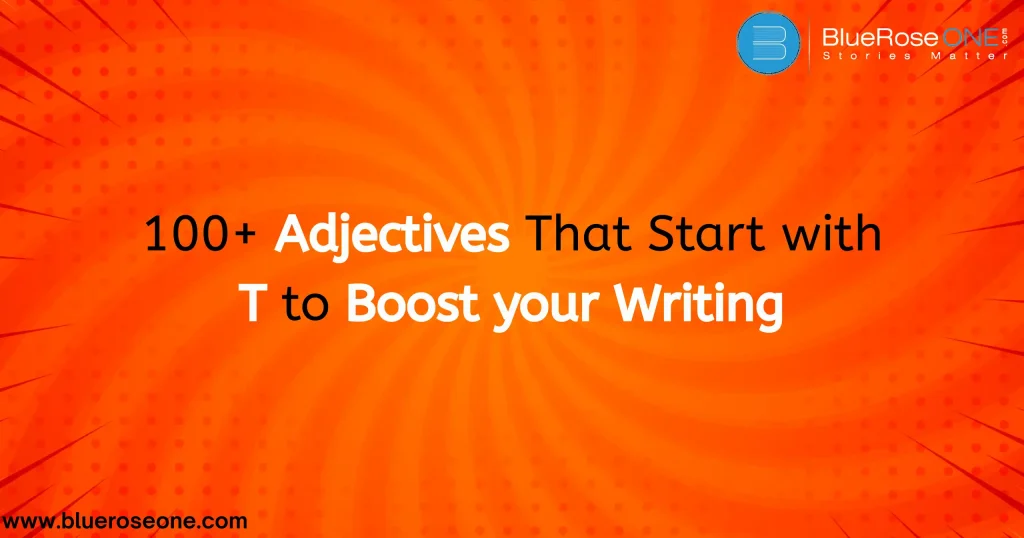
100+ Adjectives That Start with T to Boost your Writing
Ever get stuck trying to describe something in just the right way? We’ve all been there. And sometimes, all you need is the perfect adjective to make your sentence sing. That’s where this list of over 100 adjectives starting with the letter T comes in handy. Let’s face it—T-words are terrific, tenacious, and tactful. They carry tone, texture, and tenacity. Whether you’re crafting a novel, fine-tuning a blog post, or leveling up your vocabulary, these adjectives will totally transform your writing. You may also read: 100+ Adjectives That Start With N (With Examples & Definitions) Descriptive Power of T-Adjectives The Sound and Impact of “T” in Language There’s something about the crisp, sharp sound of “T” that commands attention. It’s the sound of authority, energy, and decisiveness. Words that start with T often feel tactile and real—like you can almost touch them. When to Use T-Adjectives for Maximum Effect Want to describe a determined character? A tranquil setting? A turbulent storm? T-adjectives have you covered. They’re versatile, colorful, and pack emotional punch when used right. You may also like: 100+ Adjectives Begin with N (With Meanings & Examples) Positive Adjectives That Start with T For People and Personality Traits Here are some uplifting adjectives to describe someone in a flattering light: Talented – She’s a talented artist with an eye for detail. Trustworthy – You can count on him; he’s extremely trustworthy. Tactful – She handled the situation in a very tactful way. Tender – He’s a tender soul with a big heart. Tenacious – Her tenacious spirit keeps her going through hard times. Thriving – He’s a thriving entrepreneur. For Places, Objects, and Experiences Tidy – The room was tidy and welcoming. Tranquil – A tranquil lake glistened under the morning sun. Tasty – The pie was tasty beyond words. Timeless – The decor had a timeless elegance. Top-notch – It was a top-notch performance. You may also read: 150 Adjectives Begin with R Popular in Literature Negative Adjectives That Start with T Describing Flaws and Faults Even the darker side of life has a place in writing. Terrible – That was a terrible idea. Tactless – His tactless comment ruined the evening. Troublesome – A troublesome behavior that kept recurring. Tiresome – The lecture was tiresome beyond belief. Tawdry – Her outfit was criticized as tawdry and loud. Emotions and Moods Tense – The atmosphere became tense before the announcement. Tormented – He had a tormented expression on his face. Tearful – Her tearful goodbye broke my heart. Testy – He became testy when asked personal questions. Neutral or Contextual T-Adjectives Some adjectives can shift tone based on how you use them. Typical – It was a typical Monday. Thick – The fog was thick, but so was the tension. Tall – He told a tall tale (exaggerated), or he’s just tall. Tangible – The excitement was tangible in the room. You may also like: Adjectives that starts with e | Words Popular in Literature Polished Vocabulary for Resumes and Reports Want to impress in your resume? Task-oriented Tech-savvy Team-spirited Tactical Timely These add power and precision. You may also like: 100+ Adjectives That Start with C (With Definitions & Examples) You may also like: 20 Satire Examples in Real-World Every Writer Should Know List of 100+ Adjectives That Start with T Here’s your go-to treasure trove of T-adjectives: Talented Tangy Tasty Tactile Tame Talkative Tall Tardy Tart Tasteful Tawdry Tearful Technical Tedious Teeny Telepathic Temperate Tempestuous Tenacious Tender Tense Terrible Terrific Territorial Testy Thankful Theatrical Therapeutic Thick Thin Thirsty Thorny Thoughtful Threatening Thrilled Thrilling Thrifty Thriving Thuggish Timeless Timid Tiny Tiresome Tiring Tolerable Tolerant Toothsome Top Topical Top-notch Torrential Tortured Total Touchy Tough Towering Toxic Tragic Tranquil Transparent Treacherous Tremendous Trendy Triangular Tricky Trifling Trim Trite Triumphant Tropical Troubled Troublesome Trusting Trustworthy Truthful Tubular Tumultuous Tuneful Turbulent Twisted Typical Tyrannical Tidy Tangled Telling Tactful Tangible Tactical Taboo Talebearing Trustable Testable Twinkling Toasty Time-bound Tameable Talkable Teachy Conclusion Adjectives are like the seasoning in a dish too little, and your writing is bland; too much, and it’s overwhelming. But just the right sprinkle of T-adjectives can make your content tastefully tantalizing. Whether you want to describe a tranquil setting, a tenacious hero, or a turbulent moment—this guide should have you totally covered. Keep practicing, keep exploring, and let your words transform the page.
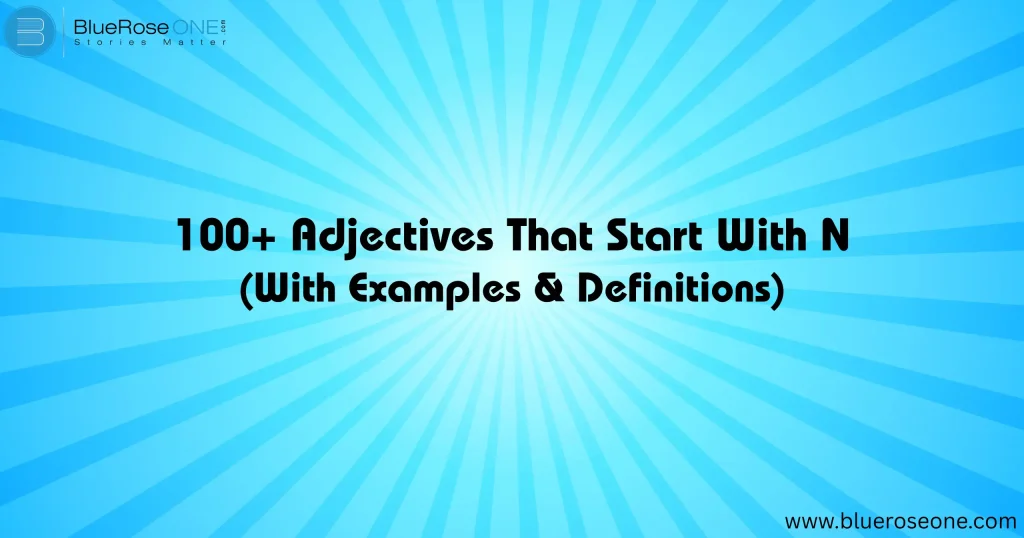
100+ Adjectives That Start With N (With Examples & Definitions)
What Are Adjectives? Adjectives are the color to your language palette. They modify nouns and pronouns, adding richness and detail to communication. Whether you’re crafting a story, complimenting someone, or just describing your day, adjectives are your best friend. Why Focus on the Letter N? Why not N? It’s a sneaky little letter, often overshadowed by flashier siblings like “S” or “M.” But N packs power — it starts with words like noble, nasty, nimble, and noteworthy. This article celebrates the charm and variety of adjectives that begin with this versatile letter. Commonly Used N Adjectives Everyday N Adjectives These are the workhorses you’ve probably heard a hundred times: New – I bought a new phone. Narrow – The street was too narrow for trucks. Natural – She wore natural makeup. Necessary – It’s necessary to eat vegetables. Examples in Sentences His neat handwriting impressed the teacher. This nasty cold won’t go away! It’s a normal reaction to stress. You may also read: Adjectives that starts with e | Words Popular in Literature Positive Adjectives That Start With N Building Positive Vibes With N-Words Inject some sunshine into your speech with these adjectives: Notable Meaning: Worthy of attention Example: She made a notable contribution to the project. Nice Meaning: Pleasant or kind Example: He is a nice person to work with. Noble Meaning: Showing fine moral principles Example: The noble knight defended the innocent. Nurturing Meaning: Caring and encouraging growth Example: Her nurturing attitude helped the child feel safe. You may also like: Adjectives Begin With S (With Examples & Definitions) Negative Adjectives That Start With N Describing Conflict, Criticism, and Flaws Nasty Meaning: Unpleasant or offensive Example: That was a nasty comment. Naughty Meaning: Behaving badly or disobediently Example: The naughty puppy chewed my shoes. Negligent Meaning: Failing to take care of responsibilities Example: The driver was negligent in following the speed limit. Narcissistic Meaning: Excessively self-centered Example: He had a narcissistic need for praise. Descriptive Adjectives That Start With N Painting Pictures With N Adjectives Narrow Meaning: Small in width Example: They walked along a narrow path. Nutritious Meaning: Providing nourishment Example: Oatmeal is a nutritious breakfast. Native Meaning: Originating in a particular place Example: The native plants thrive in this climate. Nervous Meaning: Anxious or worried Example: She felt nervous before the interview. You may also read: Top 10 Famous English Poets You Should Know Personality-Related Adjectives N Adjectives to Describe People Neat Meaning: Tidy and organized Example: His desk is always neat. Noble-minded Meaning: Possessing high principles Example: A noble-minded leader puts others first. Nosy Meaning: Overly curious Example: That nosy neighbor is always peeking over the fence. Nonchalant Meaning: Calm and unconcerned Example: He acted nonchalant, but he was really excited. Rare or Unique Adjectives Starting With N Impress With Rare Vocabulary Nebulous Meaning: Vague or unclear Example: His plans were still nebulous. Numinous Meaning: Having a spiritual or mysterious quality Example: The ancient temple had a numinous aura. Nocturnal Meaning: Active at night Example: Owls are nocturnal creatures. Nonpareil Meaning: Without equal Example: Her singing talent is nonpareil. You may also read: 100+ Positive Words to Describe Someone – You Won’t Believe #27! Adjectives Starting With N for Kids Make learning fun with simple adjectives like: Nice Nifty Nervy Nutty Use examples from cartoons or snacks to keep them engaged! Adjectives That Start With N to Describe Feelings Numb – I felt numb after the bad news. Nervous – She looked nervous before going on stage. Nostalgic – Listening to that song made me feel nostalgic. Adjectives That Start With N to Describe Places Noisy – The market was noisy and full of life. Northern – We explored the northern region of the country. Neglected – The old building looked neglected. Adjectives Starting With N in Professional Settings Negotiable – The salary is negotiable. Noteworthy – She achieved noteworthy results in sales. Necessary – It’s necessary to meet deadlines. Funny or Playful Adjectives That Start With N Nutty – He’s a bit nutty, but we love him. Nifty – That’s a nifty trick! Noodle-headed – A humorous way to say someone’s being silly. Visual Word List Table Adjective Definition Example Sentence Noble Honorable and moral He lived a noble life of service. Naughty Mischievous or disobedient The kids were being naughty. Nonstop Without pause It was a nonstop flight. Nutritious Full of nutrients Eat nutritious food for energy. Nervy Bold or audacious That was a nervy move in the meeting. Native Belonging to a region She’s a native New Yorker. Neglected Ignored or uncared for The park looked neglected. Nocturnal Active at night Bats are nocturnal animals. How to Use N Adjectives Effectively in Writing Know Your Audience – Use simpler words for general readers and rare ones for academic or literary writing. Avoid Redundancy – Don’t overuse the same adjectives in one paragraph. Match Tone – Choose positive, neutral, or negative adjectives based on the mood you want to create. Be Descriptive But Clear – Adjectives should paint a picture, not confuse. Conclusion Adjectives that start with the letter N offer an amazing range of expression from the sweet and nurturing to the downright nutty. Whether you’re a writer, student, blogger, or language enthusiast, adding these N-powered words to your vocabulary can enhance your style and spark creativity. Let this list be your guide whenever you’re hunting for the noteworthy or noble. Frequently Asked Questions 1. What is the most commonly used adjective that starts with N? New is likely the most frequently used N adjective in everyday conversation. 2. What are some powerful adjectives starting with N? Noble, notable, and numinous are strong, impactful adjectives. 3. Can you use N adjectives to describe emotions? Absolutely! Try to be nervous, numb, or nostalgic. 4. Are there N adjectives that describe nature? Yes — natural, native, and nocturnal all describe aspects of nature. 5. Why learn more adjectives starting with N? They diversify your language and allow you to express yourself more precisely and creatively.
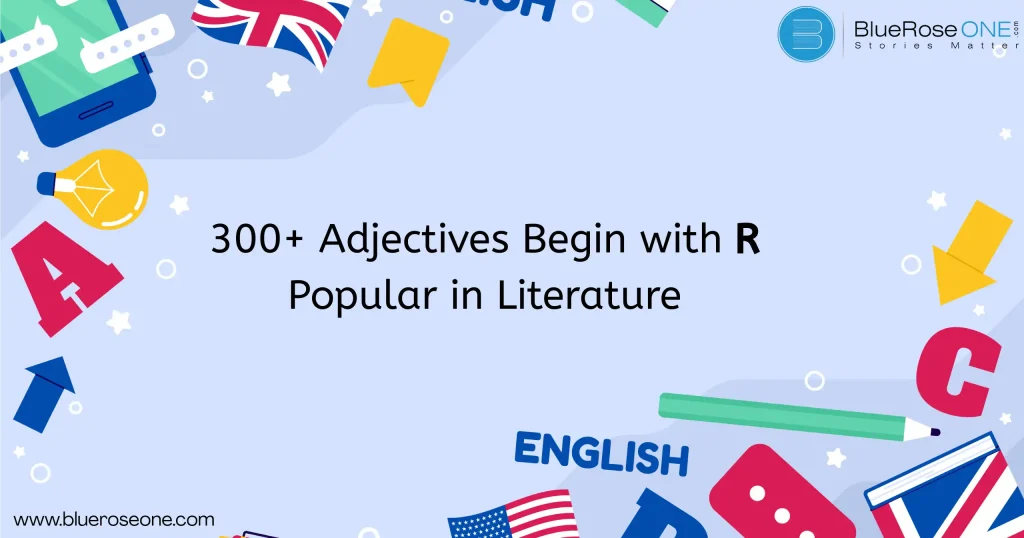
150 Adjectives Begin with R Popular in Literature
What Are Adjectives? Adjectives are those awesome words that bring our language to life. They describe, define, and give color to our nouns. Whether you’re talking about a risky adventure or a radiant smile, adjectives let you paint vivid pictures with words. Adjectives are essential for adding color, detail, and depth to our language. Whether you’re writing, speaking, or enhancing your vocabulary, knowing a variety of adjectives can make your communication more vivid and engaging. In this article, we’ve compiled over 300 adjectives that start with the letter R, widely used in American English. These words range from common descriptors to more sophisticated terms, perfect for writers, students, and language enthusiasts. You may also read: 10 Best Fiction Books Set in America You Must Read Positive Adjectives That Start With R These words convey optimism, happiness, and approval. Radiant Remarkable Reliable Resilient Respectful Resourceful Romantic Refreshing Rewarding Righteous Robust Rosy Ravishing Rejuvenating Reverent You may also like: Adjectives that starts with e | Words Popular in America Negative Adjectives That Start With R These words express criticism, disapproval, or undesirable traits. Ruthless Reckless Repulsive Ridiculous Rotten Rowdy Rusty Ragged Rancid Rebellious Redundant Repetitive Risky Rude Rampant You may also like: Adjectives Begin With S (With Examples & Definitions) Descriptive Adjectives That Start With R These words help paint a clearer picture in writing and speech. Round Rough Rapid Rare Raw Realistic Red Remote Rich Rigid Roaring Royal Rustic Rugged Ripe You may also like: Why An AI Paraphrasing Tool Is Essential For Plagiarism-Free Writing Personality & Character Adjectives That Start With R These describe traits, behaviors, and temperaments. Rational Reserved Rebellious Relentless Reliable Restless Rigorous Romantic Rude Ruthless Radiant Reckless Reflective Regal Reliable You may also read: 100+ Positive Words to Describe Someone – You Won’t Believe #27! Emotional Adjectives That Start With R These describe feelings and moods. Relaxed Relieved Remorseful Resentful Restless Reverent Rapturous Regretful Rejected Renewed You may also like: 20 Satire Examples in Real-World Every Writer Should Know Appearance Adjectives That Start With R These describe physical looks and aesthetics. Radiant Ravishing Rosy Rugged Ruddy Run-down Rustic Regal Rough Refined You may also read: Top 10 Famous English Poets You Should Know Size & Quantity Adjectives That Start With R These describe measurements, amounts, and scales. Rare Redundant Regular Remaining Repetitive Restricted Roomy Rotund Rounded Rampant You may also read: 10 Aadvika Pommu Novels That’ll Blow Your Mind (ஆத்விகா பொம்மு) Speed & Movement Adjectives That Start With R These describe motion and pace. Rapid Racing Restless Roaming Rolling Rotating Running Rushing Rustling Revolving You may also read: Top 50 Famous Dragon Names from Mythology, Books, and Movies Sound Adjectives That Start With R These describe noises and auditory experiences. Raucous Resonant Rhythmic Ringing Roaring Rumbling Rustling Raspy Rattling Reverberating You may also like: 100+ Adjectives Begin with N (With Meanings & Examples) Taste & Food Adjectives That Start With R These describe flavors and culinary experiences. Rich Ripe Robust Roasted Refreshing Rancid Raw Rubbery Rustic Buttery (Bonus: “Buttery” is often associated with rich flavors) You may also read: 10 Classic Short Stories That Will Blow Your Mind – BlueRoseONE Nature & Environment Adjectives That Start With R These describe natural elements and surroundings. Rainy Rocky Rural Rustic Rugged Radiant Rolling Rotten Raging Refreshing Advanced & Uncommon Adjectives That Start With R For those looking to expand their vocabulary with sophisticated words. Rabid Rapt Recalcitrant Redolent Refulgent Rhapsodic Ribald Risible Ruminative Ruritanian You may also read: Terrifying Horror Stories to Read Online Alone (If You Dare!) Full List of 300+ Adjectives Starting With R Here’s the extended list for reference: *(Continued list from 141 to 150)* Rambunctious Rampant Random Rank Rapacious Rapid-fire Rarefied Rascally Rash Ratty You may also like: Top 10 Eavan Boland Poems You Must Read How to Use These Adjectives Effectively Creative Writing – Enhance storytelling with vivid descriptions. SEO Content – Improve readability and keyword diversity. Everyday Speech – Make conversations more expressive. Final Thoughts Mastering adjectives that start with R can elevate your language skills, whether for writing, speaking, or professional communication. Bookmark this list for quick reference and practice using these words daily! Did we miss any important R adjectives? Let us know in the comments! Frequently Asked Questions 1. What are some powerful R adjectives for resumes? Try words like reliable, resourceful, resilient, and results-driven to impress employers. 2. Are R adjectives commonly used in American literature? Absolutely! Words like rebellious, romantic, and ruthless often appear in character descriptions and plots. 3. What R adjectives are good for describing emotions? Relieved, resentful, regretful, and raging all describe emotional states effectively. 4. Can R adjectives be used in poetry? Yes! Poets love using resplendent, rhapsodic, and radiant for imagery and emotional effect. 5. How can I memorize adjectives that start with R? Use flashcards, associate words with visuals, and practice writing short stories using as many R adjectives as possible.
